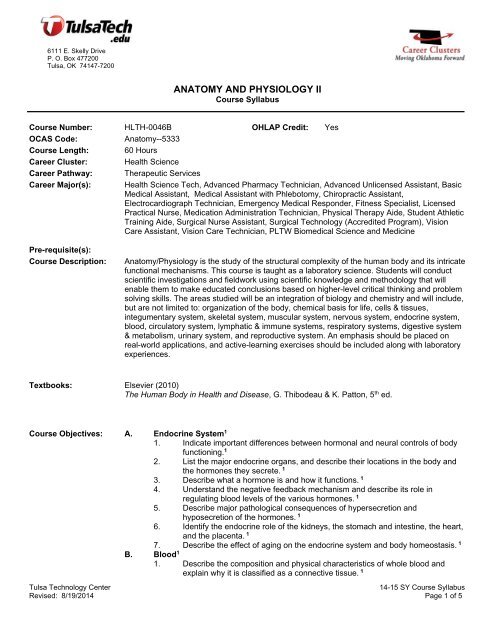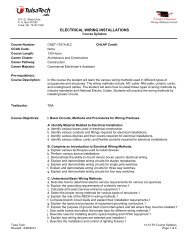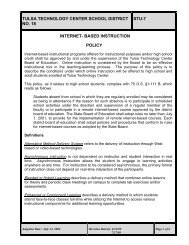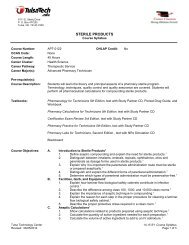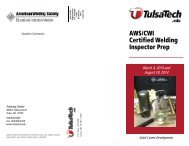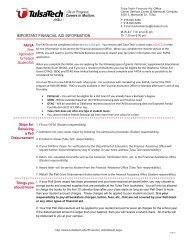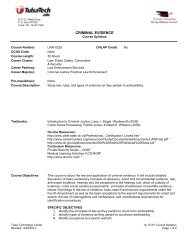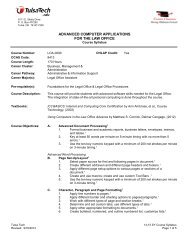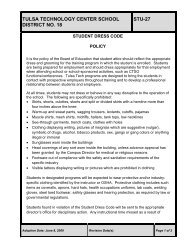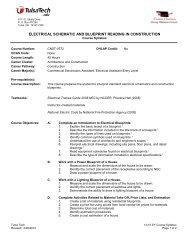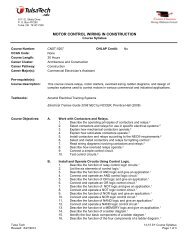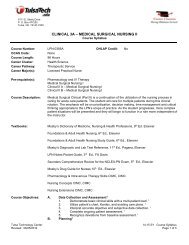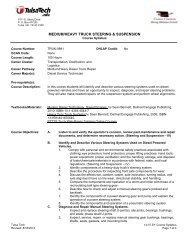Anatomy & Physiology II - Tulsa Technology Center
Anatomy & Physiology II - Tulsa Technology Center
Anatomy & Physiology II - Tulsa Technology Center
Create successful ePaper yourself
Turn your PDF publications into a flip-book with our unique Google optimized e-Paper software.
6111 E. Skelly Drive<br />
P. O. Box 477200<br />
<strong>Tulsa</strong>, OK 74147-7200<br />
ANATOMY AND PHYSIOLOGY <strong>II</strong><br />
Course Syllabus<br />
Course Number: HLTH-0046B OHLAP Credit: Yes<br />
OCAS Code:<br />
<strong>Anatomy</strong>--5333<br />
Course Length: 60 Hours<br />
Career Cluster: Health Science<br />
Career Pathway: Therapeutic Services<br />
Career Major(s): Health Science Tech, Advanced Pharmacy Technician, Advanced Unlicensed Assistant, Basic<br />
Medical Assistant, Medical Assistant with Phlebotomy, Chiropractic Assistant,<br />
Electrocardiograph Technician, Emergency Medical Responder, Fitness Specialist, Licensed<br />
Practical Nurse, Medication Administration Technician, Physical Therapy Aide, Student Athletic<br />
Training Aide, Surgical Nurse Assistant, Surgical <strong>Technology</strong> (Accredited Program), Vision<br />
Care Assistant, Vision Care Technician, PLTW Biomedical Science and Medicine<br />
Pre-requisite(s):<br />
Course Description:<br />
<strong>Anatomy</strong>/<strong>Physiology</strong> is the study of the structural complexity of the human body and its intricate<br />
functional mechanisms. This course is taught as a laboratory science. Students will conduct<br />
scientific investigations and fieldwork using scientific knowledge and methodology that will<br />
enable them to make educated conclusions based on higher-level critical thinking and problem<br />
solving skills. The areas studied will be an integration of biology and chemistry and will include,<br />
but are not limited to: organization of the body, chemical basis for life, cells & tissues,<br />
integumentary system, skeletal system, muscular system, nervous system, endocrine system,<br />
blood, circulatory system, lymphatic & immune systems, respiratory systems, digestive system<br />
& metabolism, urinary system, and reproductive system. An emphasis should be placed on<br />
real-world applications, and active-learning exercises should be included along with laboratory<br />
experiences.<br />
Textbooks: Elsevier (2010)<br />
The Human Body in Health and Disease, G. Thibodeau & K. Patton, 5 th ed.<br />
Course Objectives: A. Endocrine System 1<br />
1. Indicate important differences between hormonal and neural controls of body<br />
functioning. 1<br />
2. List the major endocrine organs, and describe their locations in the body and<br />
the hormones they secrete. 1<br />
3. Describe what a hormone is and how it functions. 1<br />
4. Understand the negative feedback mechanism and describe its role in<br />
regulating blood levels of the various hormones. 1<br />
5. Describe major pathological consequences of hypersecretion and<br />
hyposecretion of the hormones. 1<br />
6. Identify the endocrine role of the kidneys, the stomach and intestine, the heart,<br />
and the placenta. 1<br />
7. Describe the effect of aging on the endocrine system and body homeostasis. 1<br />
B. Blood 1<br />
1. Describe the composition and physical characteristics of whole blood and<br />
explain why it is classified as a connective tissue. 1<br />
<strong>Tulsa</strong> <strong>Technology</strong> <strong>Center</strong><br />
14-15 SY Course Syllabus<br />
Revised: 8/19/2014 Page 1 of 5
ANATOMY AND PHYSIOLOGY <strong>II</strong><br />
2. List the functions of blood. 1<br />
3. Discuss the composition and functions of plasma. 1<br />
4. Describe the blood-clotting process. 1<br />
5. Describe the ABO and Rh blood groups and explain the basis of transfusion<br />
reactions. 1<br />
6. Explain the importance of blood testing as a diagnostic tool. 1<br />
7. Name some blood disorders that become more common with age. 1<br />
C. Cardiovascular System 1<br />
1. Describe the location of the heart in the body, and identify its major anatomical<br />
areas on a model or diagram. 1<br />
2. Name the coverings of the heart. 1<br />
3. Describe the structure and functions of the four heart chambers. Name each<br />
chamber and provide the name and general route of its associated great<br />
vessels. 1<br />
4. Identify the elements of the intrinsic conductions system of the heart, and<br />
describe the pathway of impulses through this system. 1<br />
5. Explain what information can be gained from an electrocardiogram. 1<br />
6. Compare and contrast the structure and function of arteries, veins, and<br />
capillaries. 1<br />
7. Define vasoconstriction and vasodilation. 1<br />
8. Identify the body’s major arteries and veins, and name the body region<br />
supplied by each. 1<br />
9. Discuss the unique features of special circulations of the body: arterial to the<br />
brain, hepatic portal, pulmonary, and fetal. 1<br />
10. List and explain the factors that influence blood pressure and describe how<br />
blood pressure is regulated. 1<br />
11. Describe the structure and function of a capillary bed. 1<br />
12. Describe the fetal circulatory system. 1<br />
D. Lymphatic System and Immune Systems 1<br />
1. Name the two major types of structures composing the lymphatic system and<br />
explain how the lymphatic system is functionally related to the cardiovascular<br />
and immune systems. 1<br />
2. Describe the composition of lymph and explain its formation and transport. 1<br />
3. Describe the general location, histological structure, and functions of lymph<br />
nodes. 1<br />
4. Name and describe the other lymphoid organs of the body. Compare and<br />
contrast them with lymph nodes structurally and functionally. 1<br />
5. Describe the surface membrane barriers and their protective functions. 1<br />
6. Explain the importance of phagocytosis and natural killer cells in nonspecific<br />
body defense. 1<br />
7. Relate the events of the inflammatory process. 1<br />
8. Name several antimicrobial substances produced by the body that act in<br />
nonspecific body defense. 1<br />
9. Explain how fever helps protect the body against invading pathogens. 1<br />
10. Explain what an antigen and hapten is and name that act as complete<br />
antigens. 1<br />
11. Compare and contrast the origin, maturation process, and general function of<br />
B and T lymphocytes. 1<br />
12. Describe the role of macrophages and other phagocytes in immunity. 1<br />
13. Describe immunodeficiencies, allergies, and autoimmune diseases. 1<br />
E. Respiratory System 1<br />
1. Identify the organs forming the respiratory passage-way in descending order<br />
until the alveoli are reached. 1<br />
2. Describe several protective mechanisms of the respiratory system. 1<br />
<strong>Tulsa</strong> <strong>Technology</strong> <strong>Center</strong><br />
14-15SY Course Syllabus<br />
Revised: 8/19/2014 Page 2 of 5
ANATOMY AND PHYSIOLOGY <strong>II</strong><br />
3. Describe the makeup of the respiratory membrane and relate its structure to its<br />
function. 1<br />
4. Describe the structure and function of the lungs and the pleural coverings. 1<br />
5. Explain the relative roles of the respiratory muscles and lung elasticity in<br />
effecting volume changes that cause air to flow into and out of the lungs. 1<br />
6. Explain the functional importance of the partial vacuum that exists in the<br />
intrapleural space. 1<br />
7. Describe several physical factors that influence pulmonary ventilation. 1<br />
8. Explain and compare the various lung volumes and capacities. Indicate types<br />
of information that can be gained from pulmonary function tests. 1<br />
9. Describe how oxygen and carbon dioxide are transported in the blood. 1<br />
10. Describe the neural controls of respiration. 1<br />
11. Name several physical factors that influence respiratory rate. 1<br />
12. Describe the symptoms and probable causes of Chronic Obstructive<br />
Pulmonary Disease and lung cancer. 1<br />
13. Describe normal changes that occur in respiratory system functioning from<br />
infancy to old age 1<br />
F. Digestive System and Metabolism 1<br />
1. Describe the overall function of the digestive system and differentiate between<br />
organs of the alimentary canal and accessory digestive organs. 1<br />
2. List and briefly describe the major processes occurring during digestive system<br />
activity. 1<br />
3. Explain how villi aid digestive processes in the small intestine. 1<br />
4. Describe the anatomy and basic function of each organ and accessory organ<br />
of the alimentary canal. 1<br />
5. Name the deciduous and permanent teeth and describe the basic anatomy of<br />
a tooth. 1<br />
6. Describe the composition and functions of saliva and explain how salivation is<br />
regulated. 1<br />
7. Describe the mechanism of chewing and swallowing. 1<br />
8. Explain how gastric secretion and motility in the stomach are regulated. 1<br />
9. Describe the function of local hormones in the digestive process. 1<br />
10. State the roles and tell how bile and pancreatic juice are regulated in the small<br />
intestine. 1<br />
11. List the major functions of the large intestine and describe the regulation of<br />
defecation. 1<br />
12. List the major enzymes or enzyme groups produced by the digestive organs or<br />
accessory glands and name the foodstuffs on which they act and the end<br />
products of protein, fat, carbohydrate, and nucleic acid digestion. 1<br />
13. List the six major nutrient categories and note important dietary sources and<br />
the main cellular uses of each. 1<br />
14. Define metabolism and explain the difference between catabolism and<br />
anabolism. 1<br />
15. Analyze and explain the chemical reactions that provide energy for the body.<br />
Identify the means, including the structure and function of the digestive system<br />
by which energy is processed and stored within the body. 1<br />
16. Explain the importance of energy balance in the body and indicate<br />
consequences of energy imbalance. 1<br />
17. Define basal metabolic rate and total metabolic rate and name several factors<br />
that influence each. 1<br />
18. Describe how body temperature is regulated and indicate the common<br />
mechanisms regulating heat production/retention and heat loss from the body.<br />
1<br />
19. Analyze the effects of energy deficiencies in malabsorption disorders and<br />
<strong>Tulsa</strong> <strong>Technology</strong> <strong>Center</strong><br />
14-15SY Course Syllabus<br />
Revised: 8/19/2014 Page 3 of 5
ANATOMY AND PHYSIOLOGY <strong>II</strong><br />
name important congenital disorders of the digestive system and significant<br />
inborn errors of metabolism. 1<br />
G. Urinary System 1<br />
1. Describe the anatomy of the kidney and its coverings. 1<br />
2. Trace the blood supply through the kidney. 1<br />
3. Identify the parts of the nephron responsible for filtration, reabsorption, and<br />
secretion and describe the mechanisms underlying each of these functional<br />
processes. 1<br />
4. Describe the normal physical and chemical properties of urine. 1<br />
5. List several abnormal urine components and name the condition when each is<br />
present in detectable amounts. 1<br />
6. Describe the general structure and function of the ureters, bladder, and<br />
urethra. 1<br />
7. Compare the course, length, and functions of the male urethra with those of<br />
the female. 1<br />
8. Define micturition and describe the micturition reflex. 1<br />
9. List the factors that determine body water content and describe the effect of<br />
each factor. 1<br />
10. Compare and contrast the relative speed of buffers, the respiratory system,<br />
and the kidneys in maintaining the acid-base balance of the blood. 1<br />
11. Describe some congenital problems and explain the effect of aging of the<br />
urinary system. 1<br />
H. Reproductive System 1<br />
1. Describe the common function of the male and female reproductive systems. 1<br />
2. Using a model or diagram, identify the organs and accessory organs of the<br />
male and female reproductive systems and discuss the general function of<br />
each. 1<br />
3. Know the process of meiosis to the extent of comparing and contrasting it to<br />
mitosis. 1<br />
4. Outline the process of spermatogenesis. 1<br />
5. Discuss hormonal regulation of testicular function and the physiological effects.<br />
of testosterone on male reproductive anatomy. 1<br />
6. Trace the pathway of sperm cells from their site of formation to the body<br />
exterior. 1<br />
7. Describe the phases of the ovarian cycle and relate them to events of<br />
oogenesis. 1<br />
8. Describe how hormones control the activities of female reproductive organs<br />
and the development of female secondary sex characteristics. 1<br />
9. Discuss the structure and function of the mammary glands. 1<br />
10. Describe the process of fertilization and the changes of the female body during<br />
pregnancy. 1<br />
11. Understand the major functions of the placenta. 1<br />
12. Explain how labor is initiated and describe the three stages of labor. 1<br />
13. Describe the stages of human embryology and gestation including<br />
investigation of gestational and congenital disorders. 1<br />
14. Discuss several agents that can interfere with normal fetal development. 1<br />
15. Distinguish among the modes of inheritance and describe the events that lead<br />
to genetic variability of gametes. 1<br />
16. List and explain several techniques used to determine or predict genetic<br />
diseases. 1<br />
1<br />
ODCTE Objective<br />
All unmarked objectives are TTC instructor developed.<br />
<strong>Tulsa</strong> <strong>Technology</strong> <strong>Center</strong><br />
14-15SY Course Syllabus<br />
Revised: 8/19/2014 Page 4 of 5
ANATOMY AND PHYSIOLOGY <strong>II</strong><br />
Teaching Methods:<br />
The class will primarily be taught by the lecture and demonstration method and supported by<br />
various media materials to address various learning styles. There will be question and answer<br />
sessions over material covered in lecture and media presentations. Supervised lab time is<br />
provided for students to complete required projects.<br />
Grading Procedures:<br />
1. Students are graded on theory and lab practice and performance.<br />
2. Each course must be passed with seventy (70%) percent or better. Licensed Practical<br />
Nurse (LPN) require eighty (80%) percent or better due to accreditation or certification<br />
requirements<br />
3. Grading scale: A=90-100%, B=80-89%, C=70-79%, D=60-69%, F=50-59%.<br />
4. Students wanting to take advantage of college credit/alliance agreements must maintain an<br />
80% in their coursework.<br />
5. Career Major grades established during coursework are a major criteria in successfully<br />
obtaining certification.<br />
Description of<br />
Classroom,<br />
Laboratories, and<br />
Equipment:<br />
<strong>Tulsa</strong> <strong>Technology</strong> <strong>Center</strong> campuses are owned and operated by <strong>Tulsa</strong> <strong>Technology</strong> <strong>Center</strong><br />
School District No. 18. All programs provide students the opportunity to work with<br />
professionally certified instructors in modern, well-equipped facilities.<br />
Available<br />
Certifications/<br />
College Credit<br />
The student may be eligible to take state, national or industry exam after completion of the<br />
program. College credit may be issued from Oklahoma State University-Okmulgee or <strong>Tulsa</strong><br />
Community College. See program counselor for additional information.<br />
College Credit<br />
Eligibility:<br />
The student must maintain a grade point average of 2.0 or better. The following career major(s)<br />
may require a 3.0 GPA or better due to the Articulation Agreements and/or<br />
accreditation/certification requirements: Certified Dental Assistant, Emergency Medical<br />
Technician (EMT), Licensed Practical Nurse (LPN), Surgical First Assistant (SFA), Surgical<br />
Technologist, Surgical Nurse Assistant, Central Sterile Processing Technician.<br />
<strong>Tulsa</strong> <strong>Technology</strong> <strong>Center</strong><br />
14-15SY Course Syllabus<br />
Revised: 8/19/2014 Page 5 of 5


